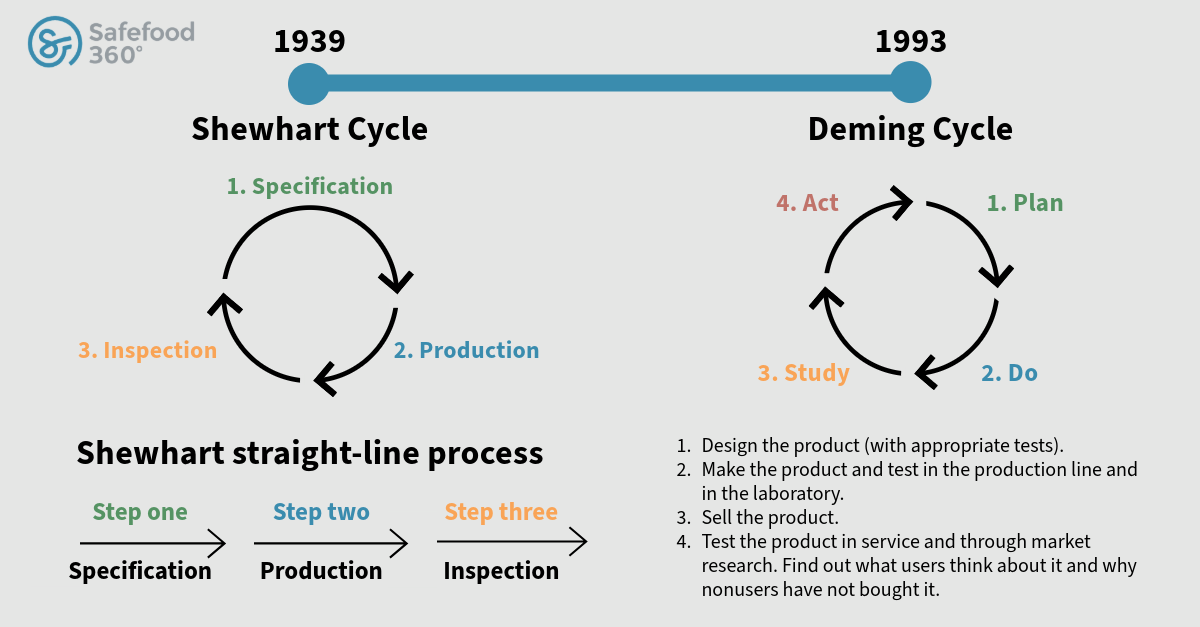Using the Plan Do Study Act Cycle for Better Food Safety Management
Today’s robust compliance systems are built in response to supply chains that are sprawling in complexity and which place demands on already limited resources.
Creating this system goes beyond appointing and empowering the right personnel, equipped with the necessary resources, to manage and enhance your food safety programmes.
While all frameworks are planned with the best of intent and often to meticulous detail, any that are built in isolation of the changing realities in which they operate under is destined to fail.
Such rigidity can lead to inefficiencies like waste, downtime, and errors in resource allocation, all of which undermine the system’s optimal performance, even worse, should such failings result in tragic outcomes when consumer safety is lacking, the effects on your brand can be cataclysmic.
At the core of your culture should be a strong foundation of processes that can provide your team assurance they are operating in the correct manner and empower them to make decisions that can lead your business in times of uncertainty.
The PDSA (or sometimes PDCA) cycle, also known as the Deming Cycle, is one such invaluable tool you can have in your arsenal that will facilitate a systemic continuous improvement of your products processes and services.
To be clear, this is just one of a plethora of different techniques and principles of Six Sigma Learnings that we will discuss in future blogs but we start here as it can be quickly deployed and without much financial cost to the business.
By incorporating a feedback loop like Deming’s ‘Plan-Do-Study-Act,’ organizations can establish a mechanism for ongoing measurement and analysis that will improve quality while reducing costs.
This cyclical process promotes continuous improvement, enabling systematic critique and enhancement of programs based on both their successes and shortcomings.
The history of PDSA Cycle and what does it mean?

The PDSA cycle has origins in a proposal by Walter A. Shewhart who created a three-step process involving Specification, Production and Inspection, which evolved into a more dynamic, cyclical model.
Building on Shewhart’s foundation, Deming transformed it into a cycle that emphasized continuous interaction among the design, production, sales and research phases. This enhanced model, which became known as the ‘Deming Wheel’ or ‘Deming Cycle’, was first presented during a seminal seminar in Japan in 1950.
It provided a continuous means for assessing and improving processes across a business that reduce waste, rework, investigations, litigation, and improve customer loyalty.
However, it became apparent that although widely popular as one of the facets of business improvements that became rampant in the latter half of the 20th century, the cycle was not flawless.
In the spirit of continuous improvement, Deming himself enhanced the framework and in the 1980’s changed ‘Check’ to ‘Study’.
Although you might find the words closely coupled in some thesaurus’ the change was not one motivated by vanity or irrelevance and an attempt to create new hype.
The newly enhanced PDSA is similar in that it is a four step module for process change, however, now the emphasis was to consider attention on the reflection of the metrics that are being analysed, and not just the impact of the actions.
The PDSA cycle comprises of four essential stages that when applied will form a continuous loop that following each cycle will bring you closer to your desired goal:
- Plan: Identify opportunities for improvement, set objectives and develop a detailed change plan against defined metrics which will constitute success.
- Do: Implement the plan to test its effectiveness and feasibility. This might be done on a reduced or pilot basis to mitigate disruption and test efficacy before scaling.
- Study: Monitor and evaluate the results to determine if the changes meet the objectives and identify any problems and areas for improvement. Realign your hypothesis with what you want to achieve and ensure you have defined what constitutes improvement and what changes will result in those improvements.
- Act: If successful, standardize the new process; if not, revise the plan and iterate including reviewing the objectives set out, the methods deployed, or even your null hypothesis in entirety.
It is important to remember that this is very much a live process and its value is in repetition.
What benefits does the PDSA have for Food Safety Management?
Repeating the steps of the PDSA ad infinitum will accelerate continuous improvement by promoting a culture of data-driven decision-making.
With regular performance organizations can adapt to changing conditions both internally and externally, innovate, and maintain high standards of quality.
The PDSA cycle is not just a tool for operational excellence but also a strategic approach that encourages proactive problem-solving and long-term sustainability.
Hazards can emerge at any point in your supply chain or your manufacturing process so ongoing vigilance that seeks to eliminate any variance that may introduce them is proactive step that you can take to ensuring your compliance practices exceed the standard.
The benefits of the Deming Cycle is that it can be deployed in any environment regardless of digital maturity, however, should you be considering a digital transformation project, our Business Process module is a perfect complement to it.
When up and running with a robust PDSA cycle, your business can expect the following benefits:
- Enhanced Food Safety
By systematically addressing potential food safety issues, the PAD cycle helps organisations mitigate the presence of risk.
For example, identifying contamination risks during the Plan stage and implementing sanitation processes against those risks during the Do stage can significantly improve your food safety outcomes.
Both checking and studying for their impact will allow you to monitor effectiveness, identify how to reduce variations and refine the controls implemented, creating a more robust and sustainable process.
- Continuous Improvement
Like other Six Sigma initiatives, continuous improvement is at the heart of the PAD cycle.
By regularly reviewing processes and implementing incremental changes, food safety practitioners can ensure their methods remain effective and up-to-date with industry standards.
This will mean that rather than waiting for a change in a standard or technical requirement, your team will often by excelling beyond the requirements, making any asks or demands a much easier request to facilitate.
- Data-Driven Decision Making
The Check stage emphasises the importance of using data to evaluate the effectiveness of changes.
Using empirical evidence ensures that decisions are based on measurable outcomes rather than assumptions.
We are obviously biased on this specific topic, but ensuring your Quality Management System is a living entity at the heart of your operations which uses smart solutions which foster and enable collaboration is a key step to achieving this goal.
- Standardisation
Successful changes are standardised during the Act stage, ensuring that improvements are consistently applied across the organisation.
This standardisation is crucial for maintaining high levels of quality and safety.
Once something is standardised it is not just accepted, but immediately more accessible.
With this accessibility will come scale and additional dividends as more stakeholders engage in its application and offer additional insights and areas for improvement which may go far beyond the initial hypothesis in your scope.
When to use the PDSA? Real-World Examples in Food Safety Management
It is important remember that this cycle is designed for small quick incremental improvements.
It can be used across products, services and processes, and should be deployed whenever your organization is considering organizational change or as part of wider Six Sigma methodologies.
Once you have identified your problem and opportunity you want to investigate, you will need to appraise the situation to understand that the root causes are, and clarifying what your desired end state will look like, i.e., defining what success looks like.
Here are some illustrative examples of how the PAD cycle can streamline and improve manufacturing operations:
Example 0: An illustrative framework for hypothetical scenarios
Identify a problem area across either production, your services or your process.
Once you have determined what you would like to improve, applying the PDSA cycle.
This will allow you to remedy the pain point, or provide information that will allow you to work towards improvement on the next cycle.
- Plan: Once the problem is identified, create potential solutions that may result in an improvement and determine some measurable goals for their success.
- Do: Introduce your changes on a small scale and collect sample data.
- Check: Interpret this data and compare the results against desired results. If the solution works and the results are satisfactory, proceed to the next step. If they have not, return to the Plan stage and repeat as necessary.
- Act: If the solution has worked, scale it up for deployment and roll out across all problem areas and establish it as the new pre-requisite for any future works.
Example 1: Reducing Contamination in Food Manufacturing
A food manufacturing company applied the PDSA cycle to reduce the risk of a microbiological hazard contamination in its production line:
- Plan: Identified the opportunity for enhanced checks in the sanitation processes.
- Do: Introduced the new sanitation process on a small selection of products and production lines.
- Study: Performed microbial testing and ATP swabs to assess effectiveness, both on the line and products, both before and after each run.
- Act: Once the results could be interpreted and the affect of change was deemed desirable they integrated the new sanitation process into standard operating procedures, leading to improved food safety and quality.
Example 2: Enhancing Food Handling in a Restaurant Chain
A restaurant chain utilised the PDSA cycle to improve food handling and storage practices across their delivery chain:
- Plan: Developed a comprehensive food safety training program for all employees and made it mandatory for everyone not just those involved in direct handling.
- Do: Implemented the training program to a select group of restaurants.
- Study: Monitored and audited the trained restaurants for compliance and used both qualitative and quantitative data to test efficacy and areas for improvement.
- Act: Rolled out the training program to all restaurants and established a regular review and update schedule so the plan would remain adaptive to changes in the chain.
Example 3: Improving Cold Chain Management in Food Distribution
A food distribution company used the PDSA cycle to enhance its cold chain management:
- Plan: Identified the need for better temperature monitoring and control.
- Do: Tested different monitoring systems in a select distribution centres.
- Study: Integrated IoT devices in their Monitoring programmes to take real-time results and evaluate the effectiveness of these systems across shared records of product quality, integrity and longevity as well as any impact on its sensory characteristics.
- Act: Adopted the most effective monitoring system across all distribution centres, leading to reduced spoilage and improved food safety without impacting finished product.
Practical help to get started with the PDSA
The PDSA cycle is essential for continuous improvement in food safety management by providing a mechanism for planning, implementing, evaluating, and refining food safety practices.
In a dynamic market where food safety standards are continually evolving and risks are ever present, the PDSA cycle offers a great platform to adapt effectively.
By planning improvements, executing changes, evaluating outcomes, and standardizing successful processes, food manufacturers can proactively address emerging risks and stay ahead of regulatory updates.
However, we recognise that getting started with any transformation projects can be a difficult ask when your teams are preoccupied by their day to day.
Our platform supports continuous improvement by offering tools that help food businesses maintain high safety standards and achieve operational excellence.
Through features such as custom workflows, configurable risk assessments, real-time monitoring and customizable reporting with natively integrated Business Intelligence layers, Safefood 360° empowers organizations to stay proactively in control of their data.
We proudly join other our partner brands such as BRCGS across the LGC Group that have provided assurance, quality, and trust to food manufacturers, importers, and governments for over 180 years.
Talk to us today to see how we can ensure the success of the digital transformation of your food safety system and excel at deploying these Six Sigma initiatives and other management practices.
Our team of in-house food safety experts will offer full support that take the pain out of compliance and give you peace of mind, and are just a click away.












Leave a Reply
Want to join the discussion?Feel free to contribute!